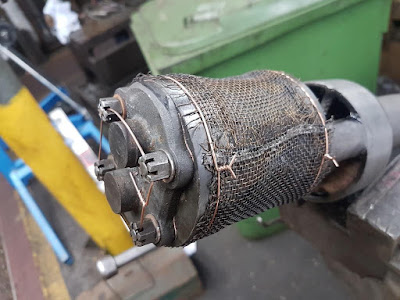Photos by
Rob Bishop.
The current state of the Mclaren MDB4 engine, after return from Cast Iron Welding Services
The damage to the crank case has now been made good:
This shows the case before repair
(Not the best set of pictures to illustrate the repair; we do not appear to have a good picture of the damage, but comparison of the above photo and the next photo shows the missing bit which has been replaced)
Crankcase after repair
The next task on the crank case and engine block is to skim the two mating surfaces to ensure that they are both true and oil tight. There is a large milling machine at Dinas so this is a task that can be carried out in-house.
The repaired area of the crankcase can be seen in more detail in this view. The
damaged crankshaft can also be seen.
Flaw detection
has confirmed that the damage is confined to the shaft itself and
there is no cracking in the adjacent crank.
In addition to the dye penetration test the crankshaft was set up in some ‘V’ blocks
to allow the main bearings to be checked with a clock gauge.
This confirmed that the shaft is not bent. The jury is still out on whether we repair or replace the crankshaft.
The pinion on the left drives a chain of gears to the camshaft and also the oil pump (see below).
While
decisions are pondered on the big bits, progress continues on the
ancillaries:
This is the oil pump assembly, driven by the gear on the crankshaft as seen in the previous photo.
For this photo, the pump has been placed on the line of the crankshaft. It is normally located in the engine inside the large hole seen directly below it. There is an idler gear on the spindle visible here below the pump, so the crankshaft gear drives the idler, which in turn drives the pump itself (see the lubrication diagram below)
This diagram illustrates the lubrication system, showing the pump and the gear train.
In the
diagram there appear to be a number of pipes which lead to the crank
shaft bearings. In practice these ‘pipes’ are formed of a series
of interconnected oilways drilled into the crank case and engine
block.
The routes of these oilways have been marked up on the block in
the photo below. At the end of each run there is a plug. There is an
oil way from one end of the block to the other, with individual
branches leading to each crank shaft bearing location.
The
lozenge shaped cover is to the oil strainer and the fitting behind it
is the oil pressure relief valve (the diagram is very diagrammatic!).
If you look carefully at the lubrication diagram you can see that there is also an oilway in the crankshaft itself, which takes oil from each bearing and feeds the big end - and in turn the little end on the adjacent con rod.
The set screw in this photo of the damaged crankshaft is the plug on the end of one of these oilways.
Two more
shots of the oil pump to close with:
This is the pump body
This photo shows the pump in place inside the crankcase
The banjo connection is on the oil line from the pump to the strainer.












